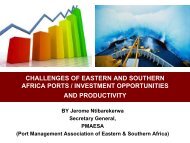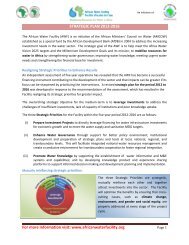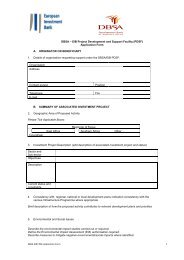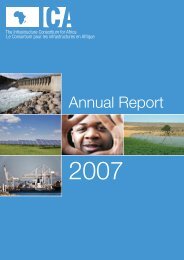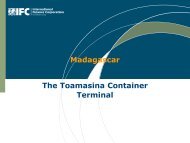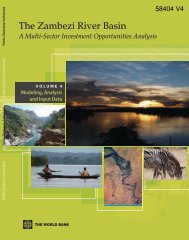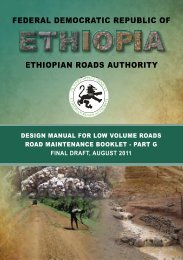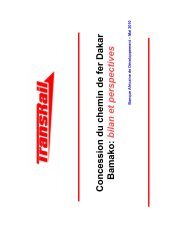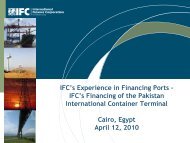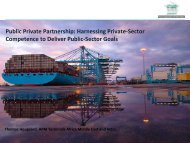AFRICA INFRASTRUCTURE COUNTRY DIAGNOSTIC - The ...
AFRICA INFRASTRUCTURE COUNTRY DIAGNOSTIC - The ...
AFRICA INFRASTRUCTURE COUNTRY DIAGNOSTIC - The ...
Create successful ePaper yourself
Turn your PDF publications into a flip-book with our unique Google optimized e-Paper software.
<strong>AFRICA</strong> <strong>INFRASTRUCTURE</strong><br />
<strong>COUNTRY</strong> <strong>DIAGNOSTIC</strong><br />
Introductory Overview<br />
1
Background<br />
Following the October 2005 inaugural meeting of the Infrastructure Consortium for<br />
Africa meeting in London, a decision was taken to initiate a major study of the country<br />
level situation of the infrastructure sectors in Africa: the Africa Infrastructure Country<br />
Diagnostic (AICD) Study.<br />
In the context of recent pledges by the international community to substantively increase<br />
aid flows to Africa (and to African infrastructure in particular), the objective of the AICD<br />
is to achieve a major improvement in the country level knowledge base of the infrastructure<br />
sectors in the region. This will provide a baseline against which future improvements in<br />
infrastructure services can be measured, making it possible to monitor the results achieved<br />
from the anticipated increase in donor support. It should also provide a more solid<br />
empirical foundation for prioritizing investments and designing policy reforms in the<br />
infrastructure sectors in Africa<br />
<strong>The</strong> World Bank is responsible for the implementation of the study, in coordination with<br />
the African Development Bank, and under the overall guidance of the African regional<br />
institutions (AU, NEPAD and the RECs), as well as the major donors. This initiative is<br />
closely related to the Medium to Long Term Strategic Framework (MLTSF) study, which<br />
is being undertaken concurrently by the African Development Bank on behalf of NEPAD.<br />
<strong>The</strong> two studies essentially complement each other, insofar as the AICD focuses on basic<br />
data collection to document the infrastructure situation within countries, while the MLTSF<br />
focuses on the strategic framework and road map for the cross-border infrastructure needed<br />
to promote regional integration.<br />
Scope<br />
<strong>The</strong> AICD consists of a broad-based data collection exercise combined with a wideranging<br />
program of analytical work that builds upon this data platform. <strong>The</strong> country level<br />
data collection effort will focus on three pillars that together provide a comprehensive<br />
picture of the situation of each of the infrastructure sectors.<br />
a) Fiscal costs<br />
b) Investment needs<br />
c) Sector performance indicators<br />
In essence, the fiscal costs study will cover the historic financing picture, the investment<br />
needs studies will portray the future financing requirements, and the sector performance<br />
indicators will clarify the scope for improvement in terms of efficiency gains as well as<br />
structural and policy reforms.<br />
a) Fiscal costs<br />
One key area where there is virtually no systematic data available at present, is the fiscal<br />
cost of the infrastructure sectors in SSA. <strong>The</strong> fiscal accounts data collected by the IMF<br />
2
are scattered and incomplete with respect to their coverage of infrastructure, and at best<br />
highly aggregated. <strong>The</strong>re is no clear breakdown of infrastructure costs by sectors, or<br />
functional outlays that distinguish for example between capital, maintenance and<br />
operating expenditures.<br />
Thus, the AICD aims to create a standardized and systematic baseline on the fiscal costs<br />
of infrastructure in each of the countries based on the last 3-5 years of public expenditure<br />
data. <strong>The</strong> study will be comprehensive in its coverage of public expenditure on the<br />
infrastructure sectors, including both central and sub-national government expenditures,<br />
off-budget vehicles (such as road funds and others), state-owned enterprises, and<br />
subsidized private sector providers. By documenting the public finance situation of the<br />
infrastructure sectors, the study will identify the extent of fiscal space for public<br />
investment and the potential need for private finance of infrastructure.<br />
<strong>The</strong> study will follow a clearly specified methodology that involves a detailed<br />
decomposition of both infrastructure expenditures and funding flows to the infrastructure<br />
sectors. Expenditures will be disaggregated according to infrastructure sub-sectors and<br />
functional categories such as investment, rehabilitation, maintenance, operations, etc.<br />
Funding flows will be disaggregated according to infrastructure sub-sectors and<br />
functional categories such as own resources, central budget allocations, loans, etc. <strong>The</strong><br />
data will be obtained from realized budgets of the public sector and accounts of State-<br />
Owned Enterprises. State subsidies provided to private providers of infrastructure<br />
services will also be considered.<br />
As a complement to the work on the aggregate fiscal costs, an additional component of<br />
the AICD study will examine project level expenditure data to establish unit cost<br />
information on infrastructure projects in SSA. Most donor agencies generate project<br />
completion reports of various kinds and archive tender documents and civil works<br />
contracts that provide quite detailed information on expected and realized project costs<br />
and project outputs, and that sometimes analyze the rate of return on investments made.<br />
This source of data, though relatively accessible, has never been systematically reviewed<br />
and analyzed with a view to generating data on the unit costs of various different types of<br />
infrastructure investments.<br />
<strong>The</strong> unit cost study will perform a systematic review of infrastructure project completion<br />
reports and contractual documents for SSA. Based on these reports, the study will<br />
generate a project database detailing physical outputs, unit costs, rates of return, duration,<br />
and other relevant project performance indicators. <strong>The</strong> unit cost exercise will pool the<br />
project records of several donors that have agreed to participate including the African<br />
Development Bank, the European Commission, the European Investment Bank, Japan<br />
and the World Bank.<br />
b) Investment needs<br />
<strong>The</strong> limited evidence currently available on investment needs for infrastructure in SSA<br />
falls into two categories. On the one hand, there are high level ‘top-down’ cross-country<br />
3
studies that estimate investment needs based on macro-economic data and unit cost<br />
parameters (see for example Fay and Yepes 1 ). <strong>The</strong>se types of studies provide useful<br />
internationally consistent first order approximations of investment needs, but are so<br />
generic that they fail to do justice to country level specificities. On the other hand, there<br />
are country specific ‘bottom-up’ estimates of investment needs based on very detailed<br />
engineering studies of the sector. Such studies may be much more accurate; however,<br />
they also have a number of disadvantages associated with them. <strong>The</strong>y are costly to<br />
produce, are not available for all countries and sectors, and tend to adopt a wide variety<br />
of methodologies that limit their comparability across countries.<br />
For the purposes of the AICD, five different studies of investment needs are envisaged<br />
for the ICT, irrigation, power, transport, and water and sanitation sectors respectively.<br />
<strong>The</strong> objective is to develop a simple but robust methodology that is significantly more<br />
accurate than the ‘top-down’ macro studies, yet substantially more straightforward and<br />
cost-effective than the ‘bottom-up’ engineering studies. <strong>The</strong> methodology will not result<br />
in a single numerical estimate of investment needs, but rather will provide a spreadsheet<br />
tool that makes it possible to simulate investment needs under a range of different<br />
assumptions about economic growth, social objectives, unit costs and other relevant<br />
parameters. <strong>The</strong> value of developing a modeling tool rather than a specific numerical<br />
estimate for investment needs is that it will permit an iterative process of finding a<br />
balance between investment needs and available investment resources.<br />
<strong>The</strong> five investment needs studies will consider both market driven investments to keep<br />
pace with the demands generated by a growing economy, as well as politically<br />
determined investment targets to meet social needs that may not be commercially<br />
lucrative without government subsidy (for example, rural telephony or electrification).<br />
In the case of market driven investments, the studies will project demand for<br />
infrastructure services based on historic trends in economic growth and other relevant<br />
drivers. Particular attention will be paid to the specific infrastructure needs of high<br />
potential economic sectors. Based on these projections, the study will estimate the cost of<br />
investments in infrastructure required to meet this incremental demand, under a range of<br />
alternative technological options.<br />
In the case of socially motivated investments, the studies will identify any relevant<br />
national and international targets for access to infrastructure services and estimate the<br />
associated cost of meeting this demand. A range of technological options will be<br />
considered of relevance to both peri-urban and rural settings.<br />
In addition to quantifying investment needs, the study will also estimate the costs of any<br />
rehabilitation required in order to restore the effective functioning of existing<br />
infrastructure and the maintenance expenditure required to preserve the serviceability of<br />
new and existing infrastructure assets in each of the countries concerned. <strong>The</strong>se estimates<br />
will be based on locally grounded unit cost parameters.<br />
1 Fay, M. and Yepes, T. (2003) “Investing in infrastructure. What is needed from 2000 to 2010?”, Policy Research<br />
Working Paper Series No. 3102, World Bank, Washington DC.<br />
4
c) Sector performance indicators<br />
In order to develop a detailed portrait of the infrastructure sectors in SSA, it is necessary<br />
to build up a database of sector indicators for each sector and each country. <strong>The</strong>se<br />
indicators will portray the current institutional framework for infrastructure service<br />
provision in each country, in terms of industry structure (horizontal and vertical<br />
integration, market concentration, ownership) and regulatory framework (nature of policy<br />
making and regulatory institutions, nature of regulations governing tariffs, service quality<br />
and competition). In addition, they will cover several different dimensions of<br />
performance including: access, affordability, efficiency, and quality of service. Careful<br />
definitions of each of these indicators will be developed, building as much as possible on<br />
existing indicator initiatives (such as the World Bank REDI Indicators and others) to<br />
ensure consistency with earlier work. To the extent possible, a time series of indicators<br />
will be collected going as far back as is practicable.<br />
<strong>The</strong> availability of indicators is currently very patchy across sectors and countries. For the<br />
ICT sector, comprehensive international databases already exist, while for the power<br />
sector there is very little systematic information available. In the case of transport the<br />
SSATPP (Sub-Saharan Africa Transport Policy Program) has good coverage on some<br />
indicators for member countries, while for water the IBNET (International Benchmarking<br />
Network) has collected utility performance data for a number of countries. <strong>The</strong> approach<br />
to be taken by the AICD is to build incrementally on existing data collection initiatives.<br />
Where a good data collection initiative exists, AICD will fund the extension of that<br />
initiative to countries that are not currently covered. In areas where there are no existing<br />
indicators, AICD will initially review data sources internal to the World Bank (including<br />
project files and various kinds of analytical work). Once this source of information has<br />
been exhausted AICD will fund country level data collection activities in order to fill the<br />
remaining data gaps.<br />
Country Coverage<br />
<strong>The</strong> AICD aims to create a comprehensive infrastructure database at the country level. In<br />
the initial phase, coverage will be confined to 24 SSA countries. <strong>The</strong>se have been chosen<br />
to be broadly representative of the diversity that exists across the region in terms of<br />
geography (coastal versus landlocked), language group (Anglophone, Francophone,<br />
Lusophone), income group and governance level. Moreover, on aggregate, they account<br />
for around 85% of the population, GDP and infrastructure aid flows to SSA. <strong>The</strong> specific<br />
countries to be covered in the first phase are: Benin, Burkina Faso, Cameroon, Cape<br />
Verde, Chad, Congo DRC, Cote d’Ivoire, Ethiopia, Ghana, Kenya, Lesotho, Madagascar,<br />
Malawi, Mozambique, Namibia, Niger, Nigeria, Rwanda, Senegal, South Africa, Sudan,<br />
Tanzania, Uganda, and Zambia. <strong>The</strong> map below illustrates the country coverage of the<br />
AICD study. <strong>The</strong> intention is that the AICD study should be extended to cover the<br />
remaining countries in Africa at a later date. However, this will depend on the availability<br />
of additional funding, which has not yet been confirmed.<br />
5
CAPE<br />
VERDE<br />
GAMBIA<br />
GUINEA<br />
BISSAU<br />
SENEGAL<br />
SIERRA<br />
LEONE<br />
MAURITANIA<br />
GUINEA<br />
LIBERIA<br />
COTE<br />
D’IVOIRE<br />
MALI<br />
BURKINA<br />
FASO<br />
GHANA<br />
TOGO<br />
BENIN<br />
EQUATORIAL GUINEA<br />
SAO TOME AND PRINCIPE<br />
NIGER<br />
NIGERIA<br />
GABON<br />
CAMEROON<br />
CHAD SUDAN<br />
ETHIOPIA<br />
CENTRAL <strong>AFRICA</strong>N<br />
REPUBLIC<br />
DEMOCRATIC<br />
REPUBLIC<br />
UGANDA<br />
OF CONGO<br />
KENYA<br />
RWANDA<br />
CONGO<br />
BURUNDI<br />
TANZANIA<br />
ERITREA<br />
DJIBOUTI<br />
SOMALIA<br />
SEYCHELLES<br />
ANGOLA<br />
NAMIBIA<br />
ZAMBIA<br />
MALAWI<br />
COMOROS<br />
MAYOTTE<br />
(Fr.)<br />
ZIMBABWE<br />
MAURITIUS<br />
BOTSWANA<br />
wb159424<br />
C:\Documents and Settings\wb159424\My Documents\Flagship\Consultation\Presentation AICD Study Full.doc<br />
MOZAMBIQUE<br />
MADAGASCAR<br />
SOUTH<br />
<strong>AFRICA</strong><br />
LESOTHO<br />
SWAZILAND<br />
Duration<br />
<strong>The</strong> AICD study is projected to run for two years from 1 st January 2006. <strong>The</strong> first year<br />
will be devoted primarily to data collection activities, and the initiation of the analytical<br />
work. During the second year, the analytical work will be completed and the Summary<br />
Report will be produced and disseminated through a series of workshops to be held across<br />
Sub-Saharan Africa.<br />
Governance<br />
<strong>The</strong> AICD will rely on two main channels for consultation, feedback and quality<br />
assurance.<br />
• Steering Comittee <strong>The</strong> Study Team for the AICD reports to a Steering Committee<br />
comprising regional institutions (AU, NEPAD and RECs) and the major donors<br />
(Infrastructure Consortium). <strong>The</strong> group meets at regular junctures in order to guide<br />
the direction of the research, review progress, and provide feedback on the relevance<br />
and timeliness of the analytical work. <strong>The</strong> same Steering Committee oversees the<br />
AICD and the MTLSF.<br />
• Technical Advisory Panel. <strong>The</strong> study will convene a panel of distinguished peer<br />
reviewers drawn from policy making and academic circles, both in Africa and<br />
beyond. This panel will review all of the major outputs of the study, with a view to<br />
assuring the technical quality of the work.<br />
6
All of the outputs of the AICD, including the resulting datasets and research papers will<br />
be made available to the public on the internet (www.infrastructureafrica.com ).<br />
Funding<br />
<strong>The</strong> estimated total cost of the AICD for the 24 countries to be covered in the initial<br />
phase is US$3.8 million. <strong>The</strong> study is being financed by DFID (US$2 million), PPIAF<br />
(US$1 million) and AFD (US$0.25 million). <strong>The</strong> World Bank is contributing in kind with<br />
staff time valued at (US$0.4 million). A funding gap still exists, and a number of other<br />
donors are presently considering their possible contributions.<br />
Contacts<br />
<strong>The</strong> AICD team is co-led by Antonio Estache and Vivien Foster of the World Bank’s<br />
Infrastructure Vice-Presidency and Africa Region. Any enquiries regarding the study<br />
should be directed to Vivien Foster (vfoster@worldbank.org).<br />
10/12/2006 6:36:00 AM<br />
wb159424<br />
C:\Documents and Settings\wb159424\My Documents\Flagship\Consultation\Presentation AICD Study Full.doc<br />
10/12/2006 6:36:00 AM<br />
7



